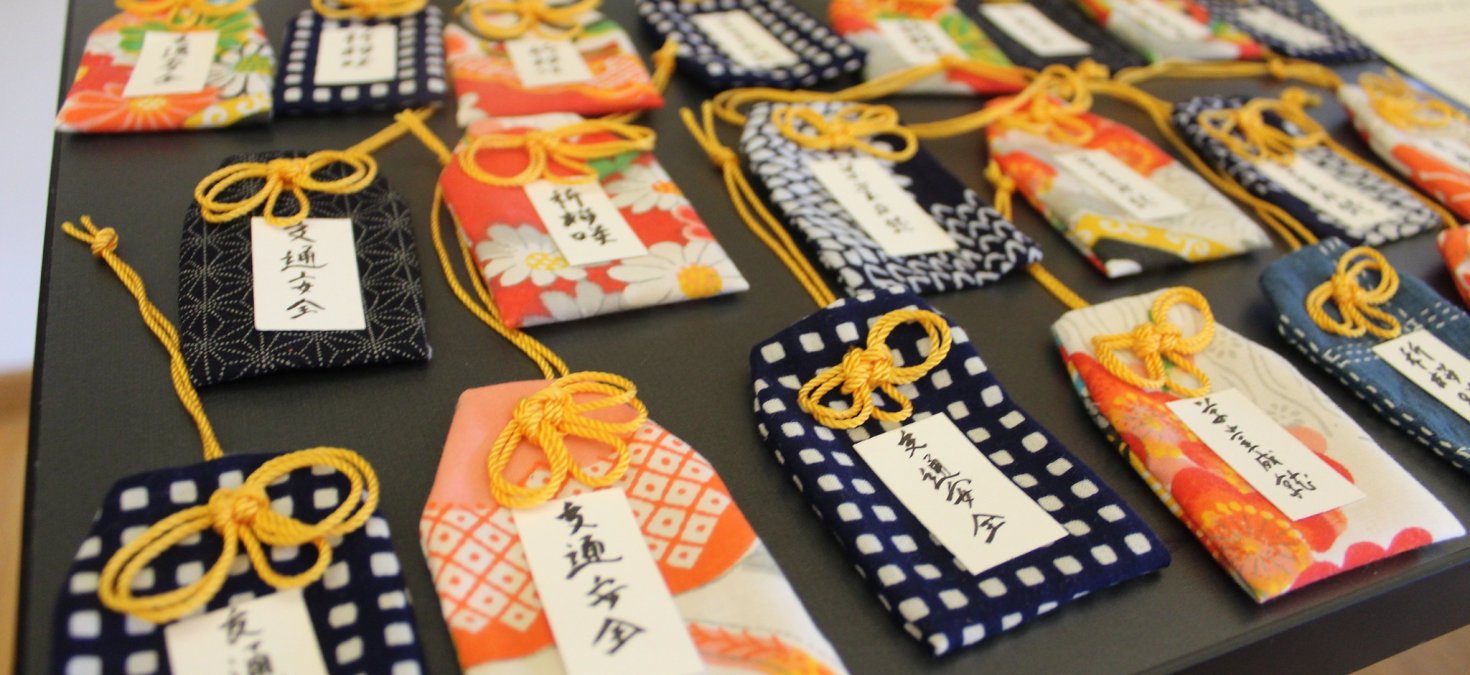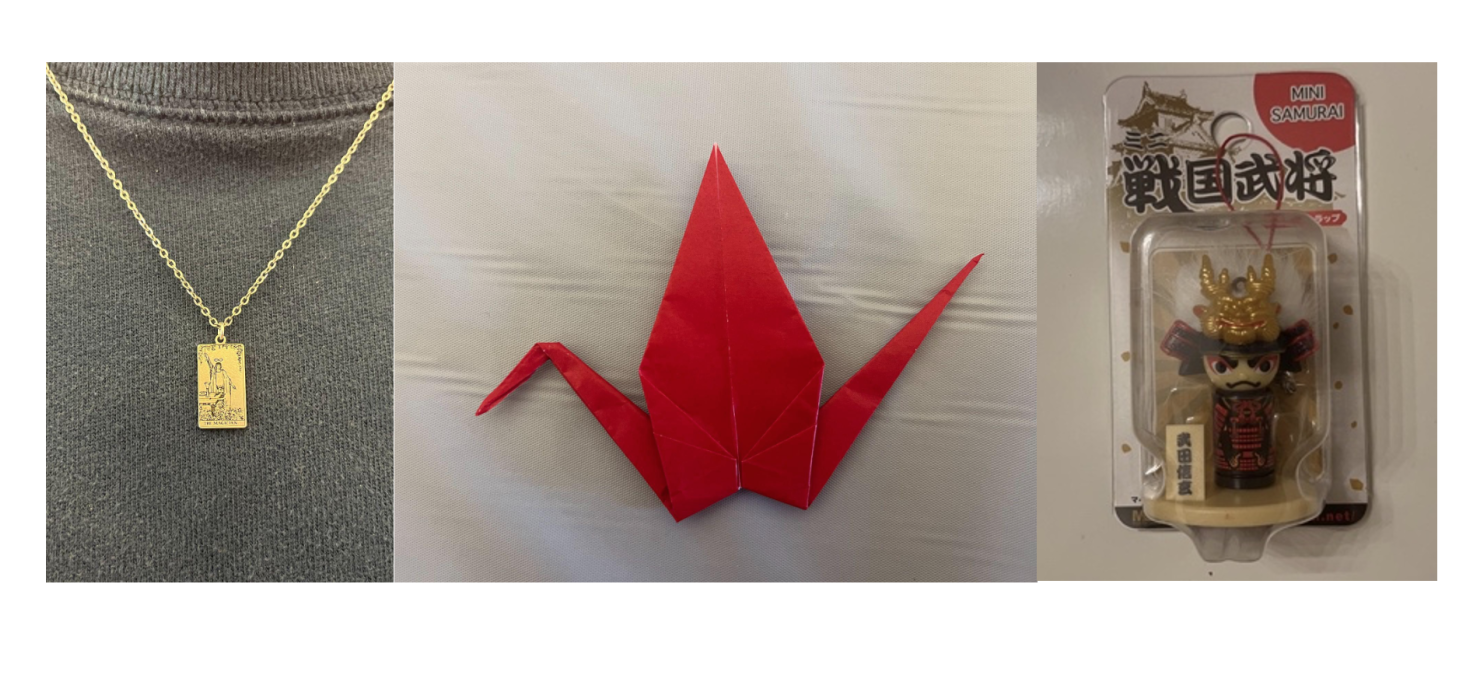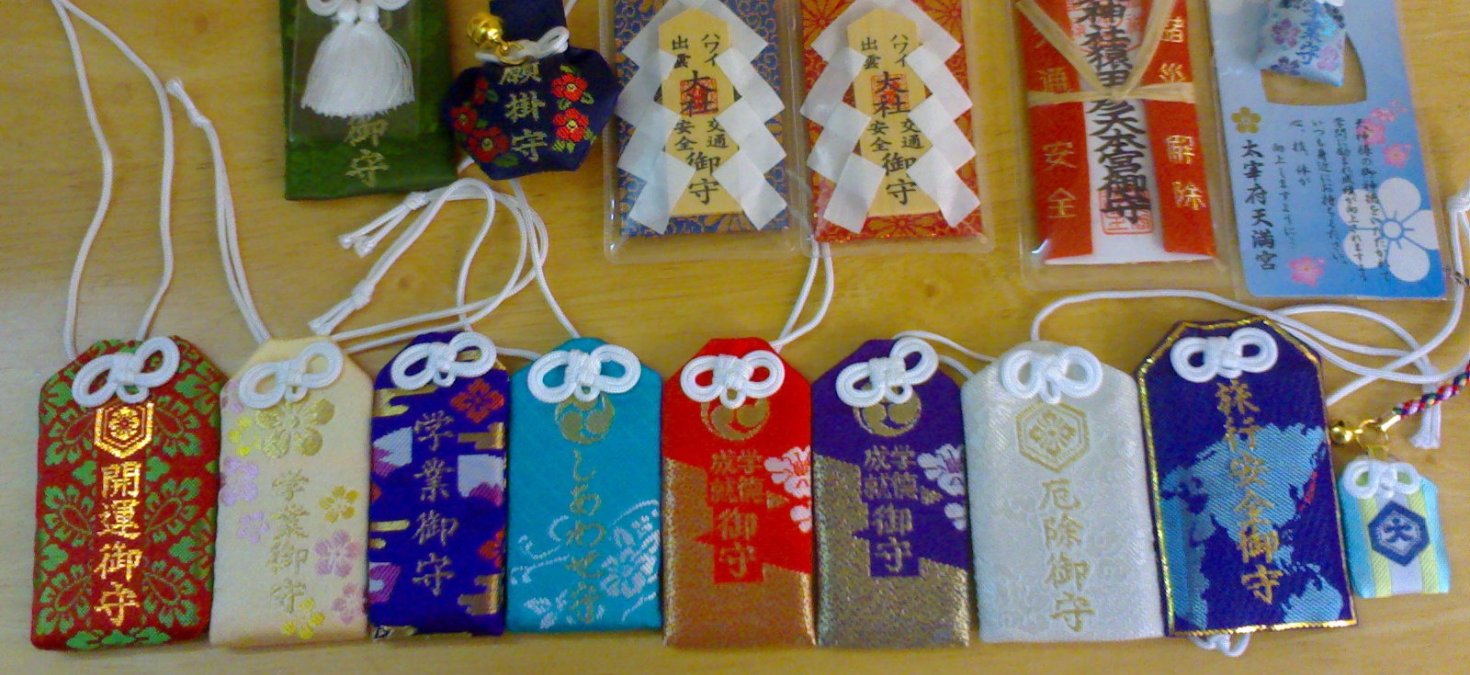Omamori: Japan’s Lucky Charm

By Cydnee Weber, Japan House Intern and Senior in History
When I asked the other interns at the Japan House about a “lucky charm” that they keep on themselves, I received a wide variety of answers. Ben told me about his tarot card pendant which is The Magician. It represents balance, willpower, resourcefulness, and harmony. Sydney has a small paper crane that she carries in her wallet and has one in the form of a sticker on the back of her phone. She’s been folding paper cranes ever since she was little, and ever since then she has seen them as a symbol of luck. As for me, I purchased a little samurai, to match with the one my friend who lives in Hawaii bought, to keep in my car. This is not only for luck, but to keep connected with her.

Around the world, many different cultures have some form of an object that they keep as a “lucky charm.” Some people will hang a rabbit’s foot in their car while others wear a hamsa necklace for protection against evil. In Japan, there is an amulet that people keep with them as well, known as the omamori (お守り).
The omamori is an amulet that is a fusion of the Buddhist amulet tradition and Shinto charms, such as the ofuda, that became popular in their current form during the Tokugawa Period in 17th century Japan. Because of this blend of religious practices, omamori can be purchased at both Shinto shrines and Buddhist temples. The Shinto omamori’s “power” comes from an enshrined kami which is referred to as go-shintai (御神体). The Kami (神) are the “divine spirits” which are venerated in Shintoism. When it comes to the Buddhist omamori, its “power” comes from a gohonzon which is the generic term for a venerated object in Japanese Buddhism. For the omamori, a gohonzon (御本尊) will take the form of a scroll with phrases and sometimes an image on it.

Various Omamori, Public domain, via Wikimedia Commons
There are only a few “rules” when it comes to the omamori. Typically, an omamori is meant to be kept on a person, such as on a backpack or purse, but this can vary depending on the purpose of the omamori. If the omamori is supposed to keep you safe while traveling, then you would keep it in your car for example. There’s no need to worry about wear-and-tear that may happen to your omamori because this can be seen as a sign that it is working.
Another important piece of information is that you should never open the omamori. Despite how tempting it may seem, opening an omamori will allow all of the blessings to be released which will render it to be completely useless.
Lastly, it is important to know that the “power” or “luck” of the omamori only lasts for about a year. After that, it is time to return your current omamori to a Shinto shrine or a Buddhist temple to receive a new one. Typically, you’ll want to return it to the same shrine or temple that you had originally gotten it from.
Originally, the omamori was developed to protect oneself from evil spirits. However, specific types of omamori have since developed to serve different purposes. Here are a few examples of scenarios where you might need a specific type of omamori.
Let’s say you really want to buy that new video-game console, but you don’t have enough money in your budget to logically pay for a $500 luxury item. You should get a shoubaihanjou (商売繁盛) or money talisman and carry it on your briefcase. If this particular omamori does its job, then you should hopefully get a raise, and then be able to afford that shiny, new PS5.
What about something for all of those lovely single people looking for someone to settle down with? There’s something for you as well. You should get an enmusubi (縁結び) which is a love talisman. However, know that priests say that this is a “slow working” omamori, so don’t expect to find your soulmate in a matter of weeks. It is “slow working” to ensure that you will have a healthy and long lasting relationship when the right person comes along. Personally, I’m considering getting one of these for myself.
Maybe you’re a college student who needs a moral boost while taking some of the most difficult courses of your major. Then, you should get a gakugyou-jouju (学業成就), or education talisman, to keep on your backpack. Although it is not designed to help you pass your tests, it will give you encouragement in all of your studies and motivate you to always do your best.

Omamori and Sensu via Wikimedia Commons
I got my brother an omamori, which was intended for general protection, from the Tsubaki Grand Shrine of America. The reason as to why I decided to get this omamori for him, is because he is a first responder, and I want him to be safe and protected. He was very pleased with the gift. I will be needing to look into getting a replacement because I believe that it has been a year since I gave it to him.
You can find traditional omamori at shrines and temples across Japan, where they have typically been blessed. In more recent years, omamori have gone through some modern redesigns. One of these transformations is with their physical appearance. In modern times, you can often find omamori at gift shops featuring characters from popular culture such as Hello Kitty. Additionally, omamori are now made that you can buy for your pet. These are typically smaller and feature a paw print as part of their design. Another popular omamori is one that is designed for sports. These feature sports motifs as part of their design and are great for athletes and fans alike.
Occasionally, shops will even sell kits to make your own DIY omamori!
Omamori are a great representation of a fusion of two religions as well as something that has slowly become more modern while also keeping most of its traditional elements. You can find omamori at shrines, temples, and gift shops, and they will always carry a special and significant meaning. This is not only because they may carry many blessings, but they represent the hopes, dreams, and desires that drive people to follow their ambitions, take risks, and go outside of their comfort zones.